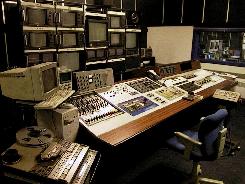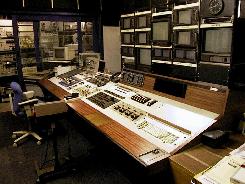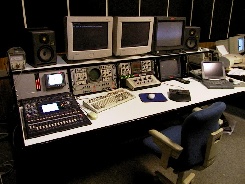|
|
| Ten
years ago, this was the state-of-the-art! Several broadcast videotape recorders
and audio tape decks, connected together via a host of dedicated "black
box" processors and interfaces, all offering some level of remote control
and a certain degree of integration. All video and audio signals were analogue,
implying the need for extremely accurate calibration and high signal-to-noise
characteristics, to avoid degradation of the programme signal on its way
through the complex path. |
 |
| Videotape editing
is based on copying small sequeces of audio or video material from one
VTR or ATR to another. Videotape is never cut during editing (although
in the late 60's it had to be!), instead it is copied, and any effects,
graphics or other processing is added between the source and recorder VTR's.
The number of layers of images which the linear system can handle in one
"pass" often dictates the use of intermediate "help-transfers" which involve
adding extra generations of copying into the final programme. Unlike its
predecessor - 35mm or 16mm acetate film - videotape is a strictly linear
medium - any changes to the finished cut require either exact replacement
of a given sequence with a sequence of identical duration, or the erasure
of the programme from the point at which the alteration must take place.
Linear editing demands a high degree of creative and technical planning,
or a substantial budget which can accomodate expensive re-cuts. |
 |
The
quality of broadcast videotape formats, especially the analogue Betacam
SP and 1" C-formats, and the many digital videotape formats, gives a recording
quality which is still acceptable for many broadcast applications. Analogue
formats suffer from multi-generation noise in both the audio and video
signal, but given a limited number of generations (typically 3 or 4), such
degradation is not perceptable by the average viewer. Within such constraints,
analogue recordings are often superior to digital recordings in that they
do not involve compression - there may be a minor noise component, but
the entire video signal is retained.
Analogue formats do however
require a high degree of skilled maintenance involving regular replacement
of expensive mechanical VTR parts. |
| However,
analogue formats continue to be employed on location and studio recordings
worldwide. Channel 6 Television still uses the renowned Betacam SP format
as its primary aqquisition format, and our archives, which still contribute
to many productions, include several analogue videotape formats. |
| One
of the major advantages of linear systems is their level of redundancy.
In most linear edit suites, there are few items of hardware which are not
duplicated, or the loss of which results in downtime for the entire suite.
In fact, in a large broadcast suite, several units may be down for maintenance
at any given time, without this affecting production. |
| Technology
has overtaken the large linear edit suite. Few broadcast production houses
would make such an investment today, where engineering costs, combined
with a relativly slow learning-curve for operators and production staff
make digital non-linear suites a far more attractive proposition. For the
production environment which still has a working linear environment, there
may be valid arguments for maintaining the facility for several years to
come, as such investments are normally written off and still able to pay
for themselves. Because of considerations concerning acquisition formats
and archive access, even digital non-linear suites need access to some
analogue equipment for playing in or out of the digital environment. |
 |
Channel
6 Television's EDIT1 was originally built in 1987, and was subjected to
a major refit in 1991 and 1997. The facility continues to operate side
by side with EDIT 2, our new digital non-linear suite. The productivity
of EDIT1 has been greatly increased by the addition of EDIT2, as complicated
graphics and multi-layer work is now undertaken on the digital suite, even
for productions in progress in EDIT1. |
| We anticipate
maintaining EDIT1 for several years yet, possibly with the integration
of non.-linear equipment into this environment. In the case of analogue
equipment, there is complete compatibility and interchangeability betyween
the two suites. |
|
|
|
|
|
|
|
|
|

